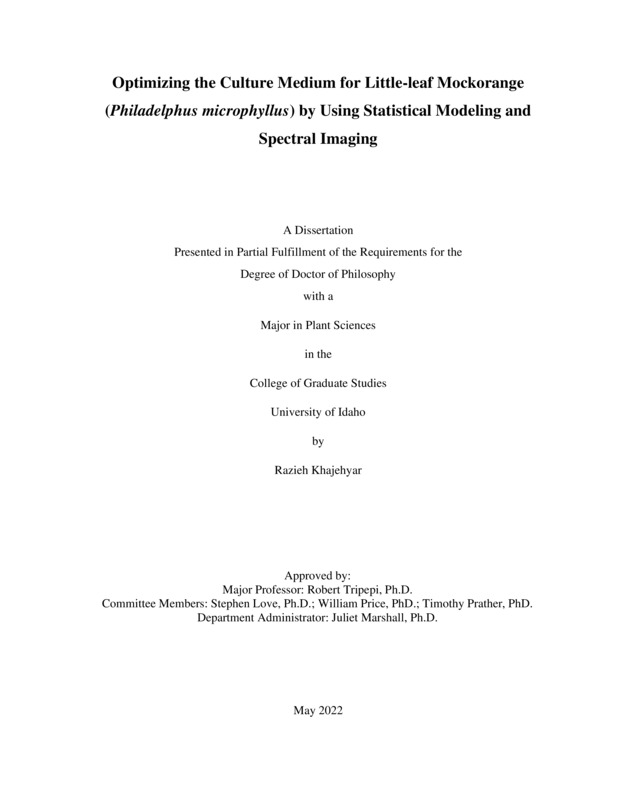Optimizing the Culture Medium for Little-leaf Mockorange (Philadelphus microphyllus) by Using Statistical Modeling and Spectral Imaging
Khajehyar, Razieh. (2022-05). Optimizing the Culture Medium for Little-leaf Mockorange (Philadelphus microphyllus) by Using Statistical Modeling and Spectral Imaging. Theses and Dissertations Collection, University of Idaho Library Digital Collections. https://www.lib.uidaho.edu/digital/etd/items/khajehyar_idaho_0089e_12294.html
- Title:
- Optimizing the Culture Medium for Little-leaf Mockorange (Philadelphus microphyllus) by Using Statistical Modeling and Spectral Imaging
- Author:
- Khajehyar, Razieh
- ORCID:
- 0000-0002-5726-2605
- Date:
- 2022-05
- Embargo Remove Date:
- 2023-04-22
- Keywords:
- cytokinins hyperspectral imaging in vitro propagation little-leaf mockorange optimization statistical modeling
- Program:
- Plant, Soil and Entomological Sciences
- Subject Category:
- Agriculture; Plant sciences; Horticulture
- Abstract:
-
Native plants are very important in urban landscape systems, as they have been adopted to the environment and are resistant to different biotic or abiotic stresses in the area. Little-leaf mockorange is a native plant in the western United States, and is a good choice for urban landscape use, while difficulties in its propagation through regular methods is a concern. In a series of studies, the potential of tissue culture to propagate this plant species was evaluated. During the completion of these studies, adjustment of tissue culture medium by changing different cytokinins and minerals was completed either as individual experiments or in the form of one experiment to run Response Surface Methods (RSM) to develop a statistical model. At the end of experiments, the feasibility of application of ASD spectroradiometer was also checked to estimate the foliar mineral status of tissue-cultured plants for studying a non-destructive method of foliar mineral prediction. Results showed that little-leaf mockorange grew best on ½ strength MS medium containing 32.5 to 35 mM N, 1.8 mM Ca, and 0.6 mM P, supplemented with 1.1 µM Zeatin. Also, using a spectroradiometer for hyperspectral imaging showed that N and Ca could be accurately estimated by developing models based on Random Forest regression models. Hyperspectral features such as, minimum external of the wavelength and asymmetric point of the wavelengths throughout the hyperspectral bands, as well as vegetation indices such as double peak index (DPI) or cellulose absorption index (CAI) were useful to provide informative data to predict foliar content of N and Ca in tissue-cultured little-leaf mockorange. this research resulted in an optimized tissue culture medium for efficient reproduction of little-leaf mockorange, so that commercial propagators can use these results to propagate this selected plant for the landscape industry.
- Description:
- doctoral, Ph.D., Plant, Soil and Entomological Sciences -- University of Idaho - College of Graduate Studies, 2022-05
- Major Professor:
- Tripepi, Robert
- Committee:
- Love, Stephen; Price, William; Prather, Timothy; Marshall, Juliet
- Defense Date:
- 2022-05
- Identifier:
- Khajehyar_idaho_0089E_12294
- Type:
- Text
- Format Original:
- Format:
- application/pdf
- Rights:
- In Copyright - Educational Use Permitted. For more information, please contact University of Idaho Library Special Collections and Archives Department at libspec@uidaho.edu.
- Standardized Rights:
- http://rightsstatements.org/vocab/InC-EDU/1.0/

